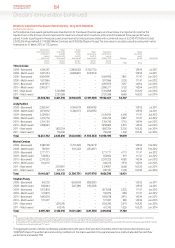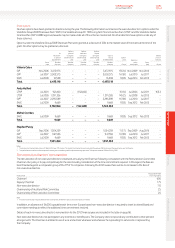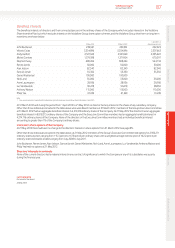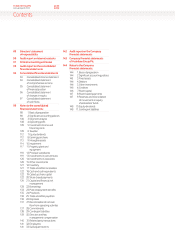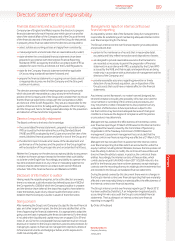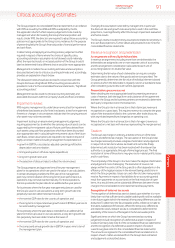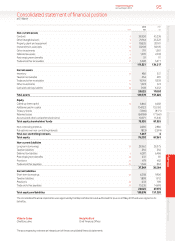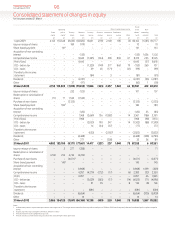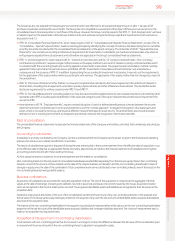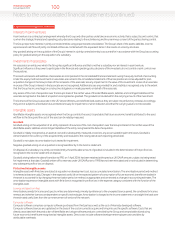Vodafone 2012 Annual Report Download - page 93
Download and view the complete annual report
Please find page 93 of the 2012 Vodafone annual report below. You can navigate through the pages in the report by either clicking on the pages listed below, or by using the keyword search tool below to find specific information within the annual report.
Business review Performance Governance Financials Additional information
91
Vodafone Group Plc
Annual Report 2012
The Group prepares its consolidated nancial statements in accordance
with IFRS as issued by the IASB and IFRS as adopted by the EU,
theapplication of which often requires judgements to be made by
management when formulating the Group’s nancial position and
results. Under IFRS, the directors are required to adopt those accounting
policies most appropriate to the Group’s circumstances for the purpose
of presenting fairly the Group’s nancial position, nancial performance
and cash ows.
In determining and applying accounting policies, judgement is often
required in respect of items where the choice of specic policy,
accounting estimate or assumption to be followed could materially
affect the reported results or net asset position of the Group should it
later be determined that a different choice would be more appropriate.
Management considers the accounting estimates and assumptions
discussed below to be its critical accounting estimates and, accordingly,
provides an explanation of each below.
The discussion below should also be read in conjunction with the
Group’s disclosure of signicant IFRS accounting policies which is
provided in note 2 to the consolidated nancial statements, “Signicant
accounting policies”.
Management has discussed its critical accounting estimates and
associated disclosures with the Company’s Audit and Risk Committee.
Impairment reviews
IFRS requires management to undertake an annual test for impairment
of indenite lived assets and, for nite lived assets, to test for impairment
if events or changes in circumstances indicate that the carrying amount
of an asset may not be recoverable.
Impairment testing is an area involving management judgement,
requiring assessment as to whether the carrying value of assets can be
supported by the net present value of future cash ows derived from
such assets using cash ow projections which have been discounted
atan appropriate rate. In calculating the net present value of the future
cash ows, certain assumptions are required to be made in respect of
highly uncertain matters including management’s expectations of:
a growth in EBITDA, calculated as adjusted operating prot before
depreciation and amortisation;
a timing and quantum of future capital expenditure;
a long-term growth rates; and
a the selection of discount rates to reect the risks involved.
The Group prepares and approves formal ve year management
plansfor its operations, which are used in the value in use calculations.
In certain developing markets the fth year of the management
planmay not be indicative of the long-term future performance as
operations may not have reached maturity. For these operations,
theGroup extends the plan data for an additional ve year period.
For businesses where the ve year management plans are used for
theGroup’s value in use calculations, a long-term growth rate into
perpetuity has been determined as the lower of:
a the nominal GDP rates for the country of operation; and
a the long-term compound annual growth rate in EBITDA in years six to
ten estimated by management.
For businesses where the plan data is extended for an additional ve
years for the Group’s value in use calculations, a long-term growth rate
into perpetuity has been determined as the lower of:
a the nominal GDP rates for the country of operation; and
a the compound annual growth rate in EBITDA in years nine to ten of
the management plan.
Changing the assumptions selected by management, in particular
thediscount rate and growth rate assumptions used in the cash ow
projections, could signicantly affect the Group’s impairment evaluation
and hence results.
The Group’s review includes the key assumptions related to sensitivity in
the cash ow projections. Further details are provided in note 10 to the
consolidated nancial statements.
Revenue recognition and presentation
Arrangements with multiple deliverables
In revenue arrangements including more than one deliverable, the
deliverables are assigned to one or more separate units of accounting
and the arrangement consideration is allocated to each unit of
accounting based on its relative fair value.
Determining the fair value of each deliverable can require complex
estimates due to the nature of the goods and services provided. The
Group generally determines the fair value of individual elements based
on prices at which the deliverable is regularly sold on a standalone basis
after considering volume discounts where appropriate.
Presentation: gross versus net
When deciding the most appropriate basis for presenting revenue or
costs of revenue, both the legal form and substance of the agreement
between the Group and its business partners are reviewed to determine
each party’s respective role in the transaction.
Where the Group’s role in a transaction is that of principal, revenue is
recognised on a gross basis. This requires revenue to comprise the gross
value of the transaction billed to the customer, after trade discounts,
with any related expenditure charged as an operating cost.
Where the Group’s role in a transaction is that of an agent, revenue is
recognised on a net basis with revenue representing the margin earned.
Taxation
The Group’s tax charge on ordinary activities is the sum of the total
current and deferred tax charges. The calculation of the Group’s total
taxcharge necessarily involves a degree of estimation and judgement
inrespect of certain items whose tax treatment cannot be nally
determined until resolution has been reached with the relevant tax
authority or, as appropriate, through a formal legal process. The nal
resolution of some of these items may give rise to material prots, losses
and/or cash ows.
The complexity of the Group’s structure makes the degree of estimation
and judgement more challenging. The resolution of issues is not
alwayswithin the control of the Group and it is often dependent on the
efciency of the legal processes in the relevant taxing jurisdictions in
which the Group operates. Issues can, and often do, take many years to
resolve. Payments in respect of tax liabilities for an accounting period
result from payments on account and on the nal resolution of open
items. As a result there can be substantial differences between the tax
charge in the consolidated income statement and tax payments.
Recognition of deferred tax assets
The recognition of deferred tax assets is based upon whether it is more
likely than not that sufcient and suitable taxable prots will be available
in the future against which the reversal of temporary differences can be
deducted. To determine the future taxable prots, reference is made to
the latest available prot forecasts. Where the temporary differences
arerelated to losses, relevant tax law is considered to determine the
availability of the losses to offset against the future taxable prots.
Signicant items on which the Group has exercised accounting
judgement include recognition of a deferred tax asset in respect of
losses in Germany (see note 6 of the consolidated nancial statements)
and the recognition of a deferred tax asset in respect of losses in
Luxembourg (see note 6 to the consolidated nancial statements).
Theamounts recognised in the consolidated nancial statements in
respect of each matter are derived from the Group’s best estimation
andjudgement as described above.
Critical accounting estimates





